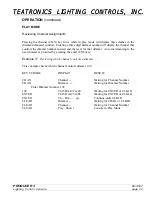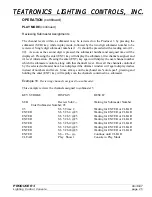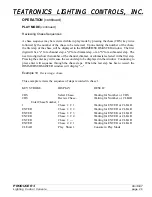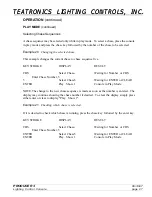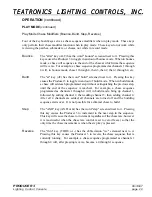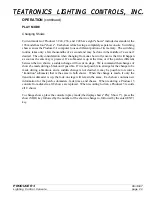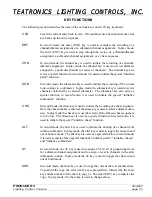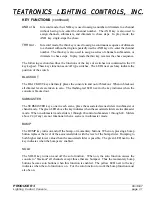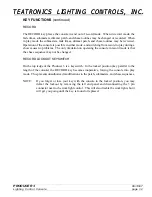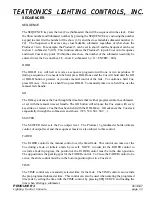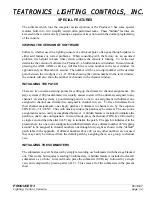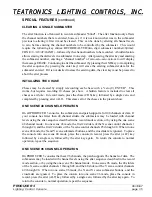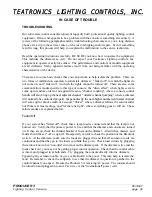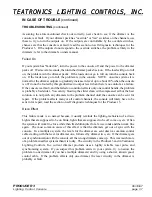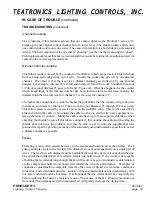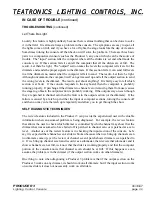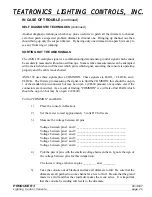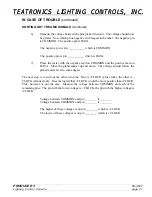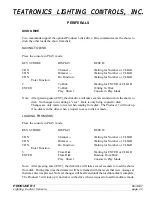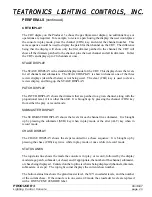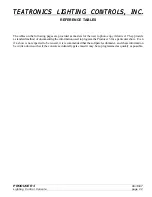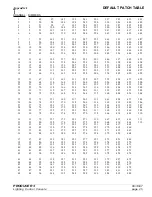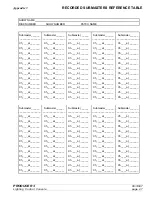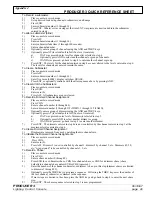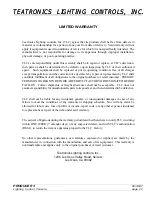
PRODUCER 3
06/18/97
Lighting Control Console
page
TEATRONICS LIGHTING CONTROLS,
TEATRONICS LIGHTING CONTROLS,
INC.
INC.
38
IN CASE OF TROUBLE
(continued)
TROUBLESHOOTING
(continued)
Channel Coupling
The symptoms of this failure mode are that one control slider on the Producer 3 acts as if it
brings up the next higher control channel but at a lower level. The failure usually affects only
one control slider and in only one scene. The cause of this failure is a bad slide pot, or associated
wiring. The bad component is the one that is "ghosting", not the one that is causing the "ghost".
Field replacement is possible but we recommend the console be returned to an authorized service
center for the correct replacement part.
Dimmer Channel Jumping
This failure mode is caused by the counter in the dimmer (which keeps track of which channel
level is being received) getting out of sync. Usually the count only gets off by one dimmer
channel. The effect is that the level for a dimmer channel gets shifted up by one channel
number. For example: dimmer 77 is at full and dimmers 76 and 78 are off. Suddenly, for about
1/15th of second, dimmer 78 goes to full and 77 goes off. What has happened is the counter
which keeps track of the dimmer number has been incremented an extra time, making the
dimmer think that the full level for channel 77 is the level for channel 78.
The higher the counter has to count, the higher the probability that the counter will get an extra
increment, so dimmers 1 through 12 may work fine but dimmers 97 through 108 may jump.
This failure mode is caused by excessive noise on the multiplex cable. This can be caused by a
broken shield in the cable or by running the cable too close to electrically noisy equipment (i.e.
large generators or motors). Multiplex cables can have up to three separate shields so when
checking the shields be sure all shields are connected. If re-routing the cable and checking the
shields does not solve the problem, you may be able to get by until the equipment can be
returned for repair by patching as many of the commonly used instruments as possible to as low
a dimmer number as possible.
Flicker
Flickering is most often caused by decay in the sample and hold circuit at the dimmer. In an
analog multiplex system, the levels for the dimmers are sent out sequentially on a single pair of
wires. The level for each dimmer must be held until the next time its level is sent down the line.
The circuit that holds this level is called a sample and hold circuit. If the circuit is not capable
of holding the level steady long enough, flicker will result. Any sort of conductive contamination
on the sample and hold circuit board will inhibit the circuit's performance. Examples of
conductive contamination commonly traced as the cause of flicker are moisture, conductive
solder flux, and certain dust particles. Luckily all these contaminants can be washed away with
hot water and dried under a hot lamp. It is important that the circuit board be completely dry
before replacing the board, as moisture is one of the causes of flicker. Blowing moisture out
from under the components with compressed air will greatly decrease the drying time.

